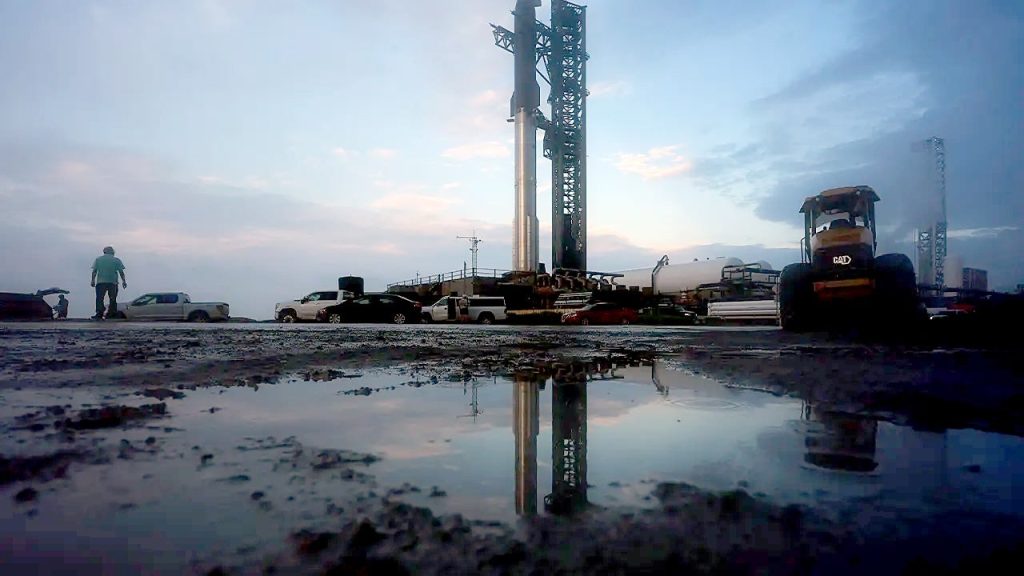SpaceX’s Starship Takes Another Shot at Historic 10th Test Flight
SpaceX’s colossal Starship rocket is poised for another attempt at its tenth test flight Monday evening, following a last-minute abort due to technical issues with ground systems. This rescheduled launch represents far more than just another test—it embodies humanity’s renewed ambitions for deep space exploration and Elon Musk’s vision of making life multiplanetary. After the Sunday evening cancellation, teams quickly regrouped to prepare for the new 7:30 p.m. ET launch window, with weather conditions improving to a 55% favorable outlook. For space enthusiasts worldwide, this launch carries the weight of our collective hopes for a future where humans might one day walk on Mars, making each test flight a crucial stepping stone toward that ambitious goal.
The journey of Starship hasn’t been without significant challenges, with the massive 403-foot rocket—the most powerful ever built—experiencing multiple dramatic failures during development. Flights 7, 8, and 9 earlier this year all ended unsuccessfully after liftoff, while another rocket suffered a catastrophic explosion on the test stand in June. These setbacks might have deterred other programs, but SpaceX has embraced them as essential learning opportunities in developing such revolutionary technology. Each failure has provided invaluable data that engineers have used to refine the design and operations of this unprecedented spacecraft. This resilient approach reflects SpaceX’s philosophy that innovation requires accepting setbacks as part of the process—a stark contrast to traditional aerospace development cycles that aim to eliminate risk before flight.
Monday’s mission will focus particularly on the spacecraft’s upper stage, which is ultimately designed to carry both humans and cargo beyond Earth orbit. This component represents the true heart of the Starship system—the vehicle that will eventually transport astronauts to the lunar surface as part of NASA’s Artemis program and, if Musk’s vision comes to fruition, carry the first humans to Mars. The test aims to demonstrate the upper stage’s ability to not only reach space but also return to Earth with a controlled descent into the Gulf of Mexico. Such a capability is revolutionary in spacecraft design, as most upper stages of traditional rockets are simply discarded after use. Successfully demonstrating this controlled return would validate a critical aspect of SpaceX’s approach to sustainable spaceflight.
Perhaps the most transformative element of the Starship program is its fundamental focus on reusability—a concept that has driven SpaceX’s approach since its founding. Unlike conventional rockets that are largely expendable, Starship is designed to be fully reusable, from its massive Super Heavy booster to the spacecraft itself. This approach directly addresses the prohibitive costs that have historically limited human space exploration. By recovering and reusing both stages of the rocket system, SpaceX aims to dramatically reduce launch costs, potentially by orders of magnitude compared to traditional systems. A successful test would mark significant progress toward proving this reusability concept works at an unprecedented scale, potentially revolutionizing access to space in the same way reusable Falcon 9 boosters have already transformed the satellite launch industry.
The intense public interest in Starship’s development reflects how this vehicle has captured the imagination of people worldwide. Unlike many aerospace projects that proceed in relative obscurity, Starship tests have become global events, with millions watching livestreams and following developments on social media. This massive stainless-steel rocket represents something profoundly human—our innate desire to explore and push boundaries. When Starship eventually succeeds in its full mission profile, it won’t just be a technical achievement for SpaceX but a milestone for humanity’s space ambitions. The vehicle’s enormous payload capacity and potential for rapid reuse could enable the construction of large structures in space, sustainable lunar bases, and eventually the infrastructure needed for human settlement on Mars—dreams that have remained in the realm of science fiction for generations.
As SpaceX prepares for this tenth test flight, the stakes extend far beyond the immediate success or failure of a single launch. Starship represents perhaps the most ambitious engineering project of our time—an attempt to fundamentally transform humanity’s relationship with space. Each test, whether it ends in a spectacular explosion or a perfect landing, provides crucial data that brings us one step closer to making life multiplanetary. This persistence in the face of setbacks exemplifies how great achievements often require accepting failure as part of the journey. Whether Monday’s test succeeds or faces new challenges, Starship’s development continues to push the boundaries of what’s possible, inspiring a new generation to look toward the stars not just with wonder, but with the genuine expectation that they might one day travel there themselves.


